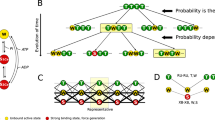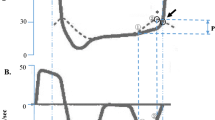Abstract
KNOWLEDGE of the processes involved in the contraction of skeletal muscle fibres has been greatly advanced by study of the ‘skinned’ fibre preparation. Here the sarcolemma is peeled off, giving access to the intracellular organelles unhampered by an intervening cell membrane. The small size of cardiac muscle cells had seemed to preclude the use of this technique, and so interest has been shown in a ‘chemical’ method for ‘skinning’ heart cells, which involves exposing the muscle to EGTA and EDTA (ref. 1). However, this paper questions the effectiveness of the EDTA/EGTA skinning methods, reporting that tension production in fully treated cells is [Na]o dependent, and that the cells can support resting and action potentials in low [K]o-‘skinning’ media. It is concluded that both the high Ca-sensitivity and low membrane potential of EGTA/EDTA-treated cells occur without radical impairment of the sarcolemmal permeability barrier. An alternative explanation for the high sensitivity to extracellular calcium is presented which involves the Ca–Na exchange mechanism.
This is a preview of subscription content, access via your institution
Access options
Subscribe to this journal
Receive 51 print issues and online access
$199.00 per year
only $3.90 per issue
Buy this article
- Purchase on Springer Link
- Instant access to full article PDF
Prices may be subject to local taxes which are calculated during checkout
Similar content being viewed by others
References
Winegrad, S. J. gen. Physiol. 58, 71–93 (1971).
Salaro, R. J., Wise, R. M., Shiner, J. S. & Briggs, F. N. Circulation Res. 34, 525–530 (1974).
Nayler, W. G. Am. J. Physiol. 225, 918–924 (1973).
Kerrick, W. G. L. & Best, P. M. Science 183, 435–437 (1974).
Fabiato, A. & Fabiato, F. Circulation Res. 31, 293–307 (1972).
Bloom, S., Brady, A. J. & Langer, G. A. J. molec. cell. Cardiol. 6, 137–147 (1974).
Mrwa, U., Achtig, I. & Rüegg, J. C. Blood Vessels 11, 277–286 (1974).
Wood, D. S., Zollman, J., Reuben, J. P. & Brandt, P. W. Science 187, 1075–1076 (1975).
Miller, D. J. & Mörchen, A. J. gen. Physiol. 71, 47–67 (1978).
Miller, D. J. & Moisescu, D. G. J. Physiol., Lond. 259, 283–308 (1976).
Beinbrech, G., Kuhn, H. J., Herzig, J. W. & Rüegg, J. C. Cytobiologie 12, 385–396 (1976).
Winegrad, S. J. gen. Physiol. 62, 693–706 (1973).
Garnier, D., Rougier, O., Gargouil, Y. M. & Coraboeuf, E. Pflügers Archs ges Physiol 313, 321 (1969).
Chapman, R. A. J. Physiol, Lond. 237, 295–313 (1974).
Fabiato, A. & Fabiato, F. J. Physiol, Lond. 249, 469–495 (1975).
Author information
Authors and Affiliations
Rights and permissions
About this article
Cite this article
MILLER, D. Are cardiac muscle cells ‘skinned’ by EGTA or EDTA?. Nature 277, 142–143 (1979). https://doi.org/10.1038/277142a0
Received:
Accepted:
Published:
Issue Date:
DOI: https://doi.org/10.1038/277142a0
This article is cited by
-
Ultrastructural and X-ray microanalytical studies of EGTA- and detergent-treated heart muscle
Journal of Muscle Research and Cell Motility (1985)
-
The contractile behaviour of EGTA- and detergent-treated heart muscle
Journal of Muscle Research and Cell Motility (1985)
-
Calcium tolerant ventricular myocytes prepared by preincubation in a ?KB medium?
Pfl�gers Archiv European Journal of Physiology (1982)
-
Sodium action potentials induced by calcium chelation in rat uterine smooth muscle
Pfl�gers Archiv European Journal of Physiology (1982)
-
Modulation of tension generation at the myofibrillar level—an analysis of the effect of magnesium adenosine triphosphate, magnesium, pH, sarcomere length and state of phosphorylation
Basic Research in Cardiology (1980)
Comments
By submitting a comment you agree to abide by our Terms and Community Guidelines. If you find something abusive or that does not comply with our terms or guidelines please flag it as inappropriate.



